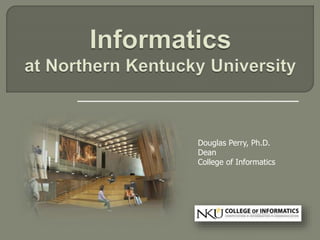
Perry: Informatics at Northern Kentucky University
- 1. Douglas Perry, Ph.D. Dean College of Informatics
- 3. Development of theories and technologies of computation, information, and communication
- 4. Development of theories and technologies of computation, information, and communication Computation: • Computer and software engineering • Data generation and acquisition • Artificial intelligence • Human-computer interaction • Simulation and virtualization
- 5. Development of theories and technologies of computation, information, and communication Information: • Properties • Processing • Storage • Retrieval • Analysis
- 6. Development of theories and technologies of computation, information, and communication Communication: • Information exchange • Content creation • Knowledge construction • Digital space • Social impact
- 7. Study of digital dystopias • Cybercrime • Information overload • Frustration • Loss of privacy • Isolation • Exclusion
- 8. Developing and deploying applications of digital technology to advance: • Arts • Sciences • Professions • Business
- 9. Health care → health informatics Filmmaking → 3-D animation Design → virtualization Performing arts → digital inflection Business → enterprise resource planning Art → interactive media Science → bioinformatics Publishing → eBooks
- 10. Commodification • Information technology is becoming off-the-shelf Integration • Data flow • Data management Convergence • Infrastructure, hardware, and software • Exponentially growing data and computing power
- 12. 1985 2010 1 experiment 1 gene 10 data points 1 experiment 10,000 genes 10,000,000 d.p.
- 13. Systems are reduced to their component elements Experiments are based on preconceived theories Results are predicted by a priori hypotheses Conclusions are drawn by deductive logic
- 14. Elements are discovered and synthesized into relational systems Data can be either experimental or empirical Theories are constructed a posteriori based on results Conclusions are drawn by inductive logic
- 15. Founded in 2005 ~1,300 students ~120 faculty members 10 majors 9 bachelor degrees 5 master’s degrees 200+ new graduates every year
- 16. College of Arts & Sciences • Dept. of Mathematics and Computer Science Computer science College of Business • Dept. of Information Systems Information systems College of Professional Studies • Dept. of Communication Speech Radio/TV/Film Journalism Public Relations
- 17. Department of Business Informatics Department of Communication Department of Computer Science Center for Applied Informatics
- 18. Dept. of Business Informatics • Business informatics, B.S. and M.S. • Health informatics, M.S. • Library informatics, B.S. (with Steely Library) Dept. of Communication • Communication studies, B.A. and M.A. • Electronic media and broadcasting, B.A. • Journalism, B.A. • Media Informatics, B.A. • Public Relations, B.A. Dept. of Computer Science • Computer information technology, B.S. and M.S. • Computer science, B.S. and M.S.
- 19. Core technologies • Computer science • Information technology Technology and people • Business informatics • Health informatics • Library informatics People and technology • Communication studies • Electronic media & broadcasting • Journalism • Media informatics • Public relations
- 20. Formed in 2006 Students employed by CAI: >150 total Students impacted by CAI : >400/year Professionals trained by CAI: 2500/year Population impacted by CAI : 750,000 Organizations served: >1000 total Grants received: >$3M total Impact on local economy: $1.5M total
- 31. Cloud computing • The end of “my” computer Mobile computing • The “Third Screen” Ubiquitous computing • The intelligent building Immersive computing • The ultimate virtualization Collaborative computing • The irrelevance of place